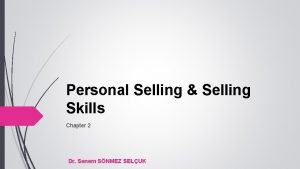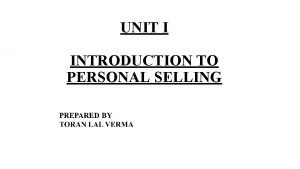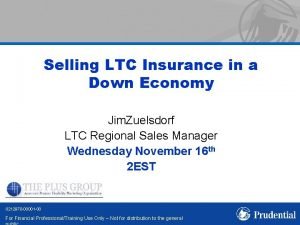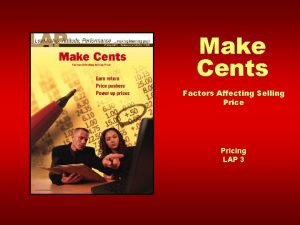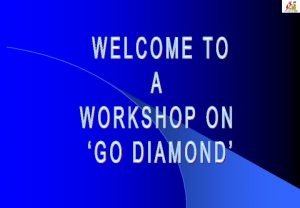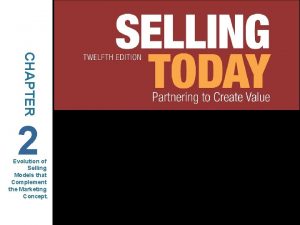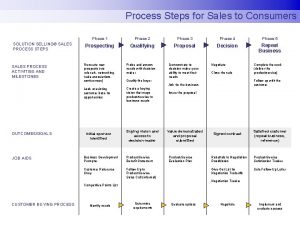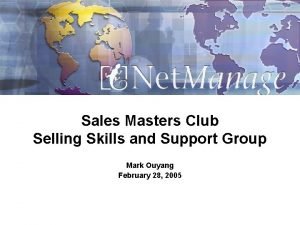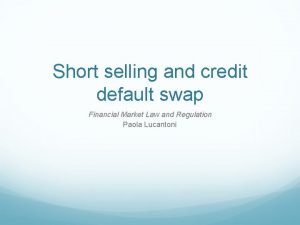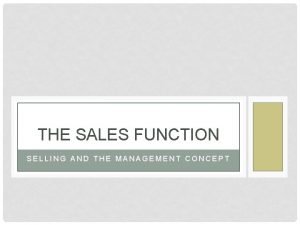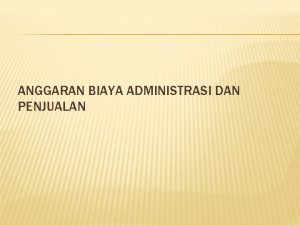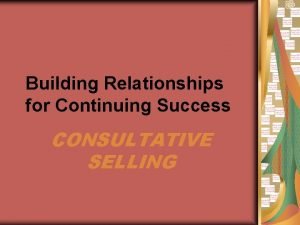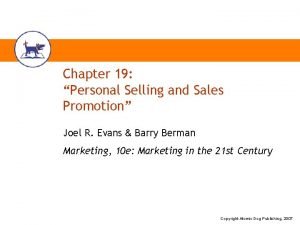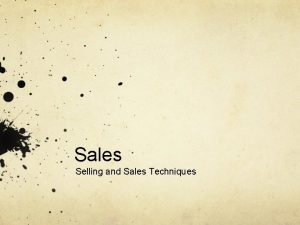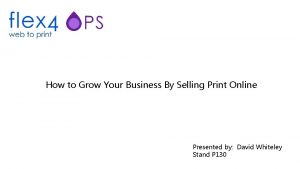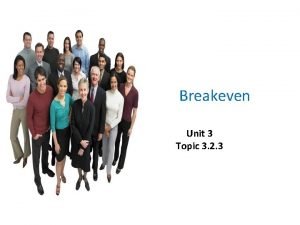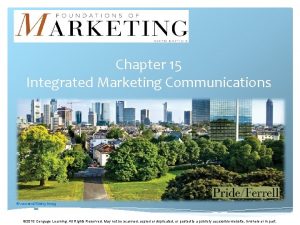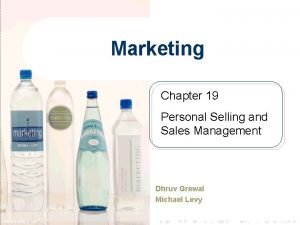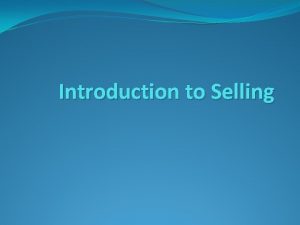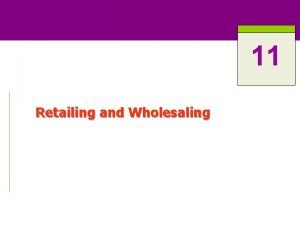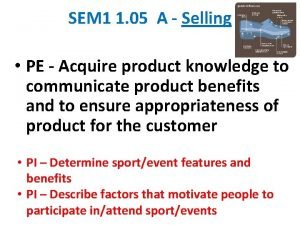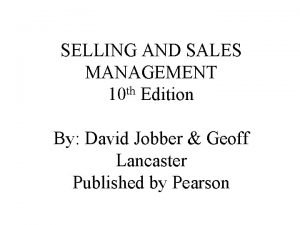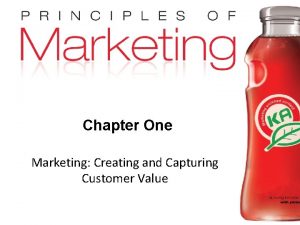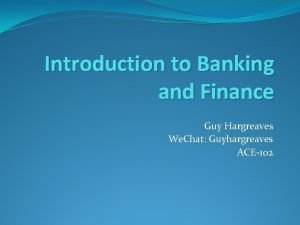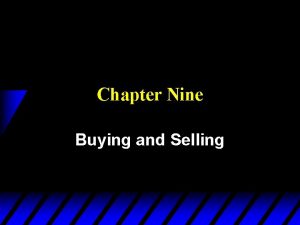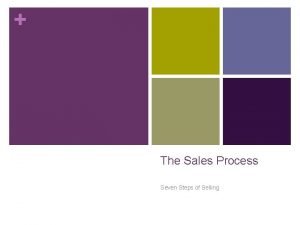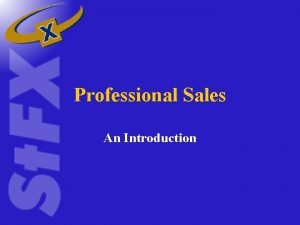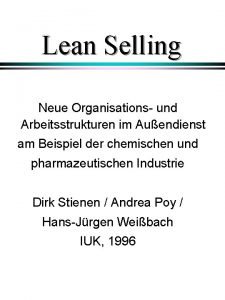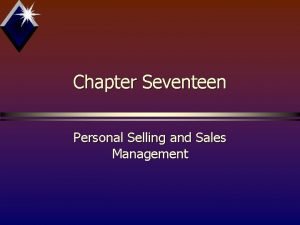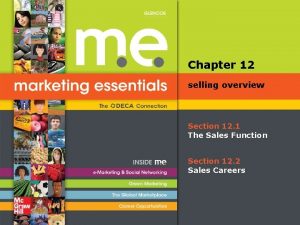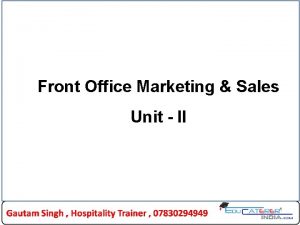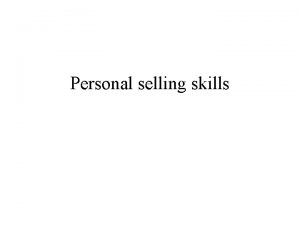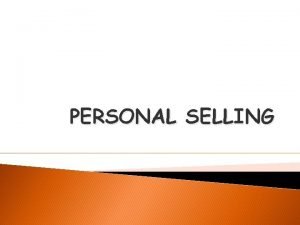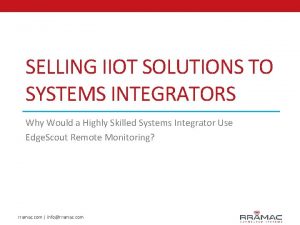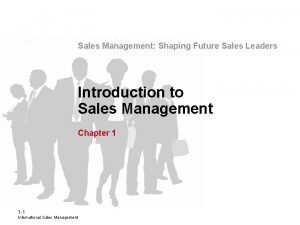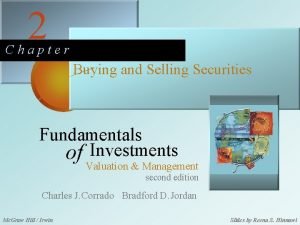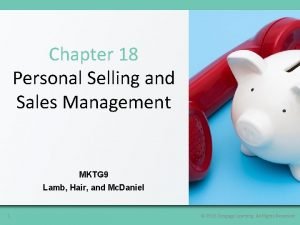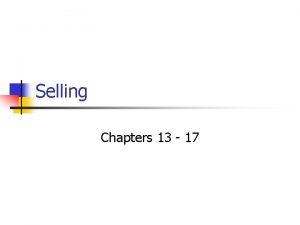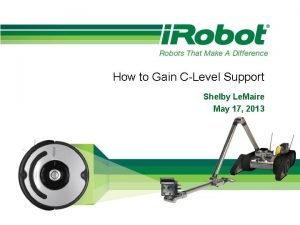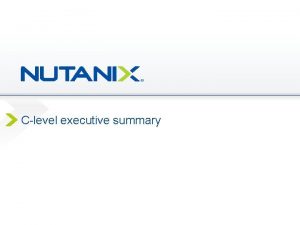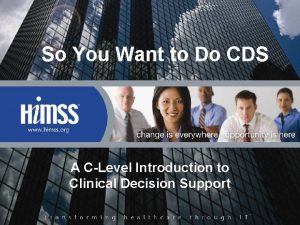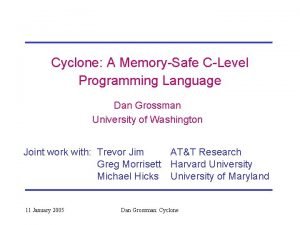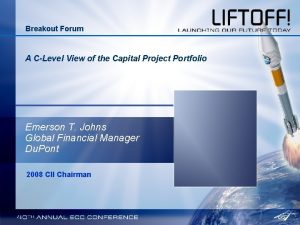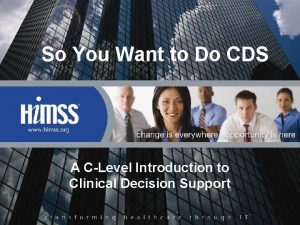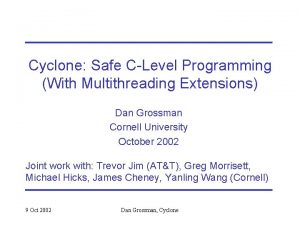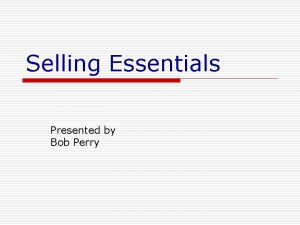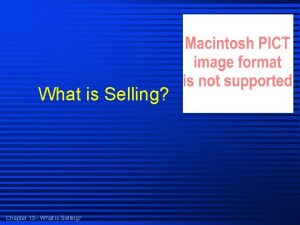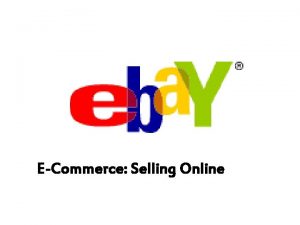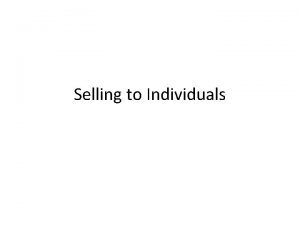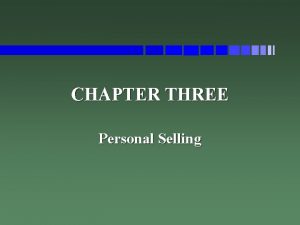Selling at CLevel May 9 2005 What is

















































- Slides: 49

Selling at C-Level May 9, 2005

What is C-Level? The management / operating board of a company • CEO, COO, CFO, CIO, CMO. . . • General Manager, VP Marketing, VP Operations. . . Who plays this role in your customers’ organizations? • LDC • Utility • Industrial. . . 2

What is different when selling to the C-Level? • What is the role of C-Level Selling? • When should you engage at the C-Level? • How is your role different in a C-Level meeting? • How does the BP message vary at the C-Level? • How do you get into conversation with the C-Level of a customer? • How to conduct a C-Level customer meeting? • What do customers want from C–Level meetings? • How to sustain momentum, agreements and achievements made at C-Level meetings? 3

C-Level Keys to Success Objectives Relationship People Structure Communication Scope Time Follow Up 4

Outline for Session The Role of C-Level Selling (why) How to be successful at C-Level Selling Scope People Timing Relationship (what) (who) (when) (how) Running a successful CLevel meeting 5

The Role of C-Level Selling • What is the Role of C-Level Selling? 6

The Role of C-Level Selling • Go beyond the deal • Float / develop the big ideas • Learn more about the customer’s strategic direction • Expand the scope - larger geography, across divisions • Expand the size – bigger % of business, longer partnership • Change of nature of the relationship - transactional to strategic • Change the direction of the relationship Are You Building BP Equity with the Customer? 7

Working in the C-Level “Zone” Step Change (nature, size, scope) C–Level Buyer’s Manager Buyer Direction Change (accelerate speed, break through, reverse) 8

How to be Successful at C-Level Selling The Role of C-Level Selling (why) How to be successful at C-Level Selling Scope People Timing Relationship (what) (who) (when) (how) Running a successful CLevel meeting 9

Case Study - A Canoe Trip in Arkansas A Canoe Trip down the Spring River 10

Procter & Gamble and Wal-mart - 1987 “Another big supplier” “Another big customer” “It was we sell, you buy, good bye” Lou Pritchard, VP Sales Procter & Gamble. Wall Street Journal January 31, 2005 11

Two companies who seemed to have little in common • Leader in many consumer products businesses (e. g. , laundry, hair care) • Fast growing mass merchandiser behind Kmart and Sears • • Consumer, but not customer driven Demanding vendor without true supplier cooperation • • “Push” focus “Sell-through” focus • • Little information exchanged with customers Little information exchanged with suppliers • • Geographic, key account sales force IT system drives decisions through Bentonville 12

A Canoe Trip down the Spring River Changing Technology More Professional Buying / Selling Sam’s Agenda • Change the nature of the relationship • Take system costs out of the supply chain • Change the P&G focus from selling in to selling out • Demonstrate the high return of an investment in Wal. Mart (e. g. , people and time) Industry Consolidation Growing Mutual Dependence 13

A Fundamental Change - 2005 • Dominant in many consumer products businesses • Consumer and customer driven • Sell-through focus • Sharing consumer research • 300 people team serving Wal-mart in Bentonville • The World’s #1 retailer with blurring the mass, food and convenience channels • Strategic vendor partnership with key suppliers • Sell-through focus • Sharing stores sales data • IT system drives business for P&G “It’s a lot like a marriage, sometimes you want to slice each other’s throats and there are other times when it is a love in” - Lou Pritchard, ex-VP Sales Procter & Gamble. Wall Street Journal January 31, 2005 14

Scope – Talking About the Right Things The Role of C-Level Selling (why) How to be successful at C-Level Selling Scope People Timing Relationship (what) (who) (when) (how) Running a successful CLevel meeting 15

The Right Scope • Are we talking about the right things. . − Strategy − Partnerships − Big Ideas − Scope / Perspective • • • − Trust Do we have clear objectives? Are our expectations aligned? Do we understand the context? Do I have the right information? HOW AM I CREATING VALUE? 16

BP Key Messages #1 Energy Merchant in the U. S. Fundamentals Gas prices rising to level that will destroy demand Demand rising from power Supply BP will provide your most reliable supply, and we are involved in every major geographical region in North America Infrastructure Need significant investment in infrastructure to connect new supply to market (low cost & efficient). Also, in 2005, many BP projects will be in the public eye. (GOM, Alaska, LNG) Regulatory The market works: a clear regulatory and policy framework allows supply, infrastructure and market to come together in a timely and efficient manner, which benefits all market participants. Market & Customers We are working to be your provider of choice, and we commit to deliver through: Service, Operations, Risk Management, Fundamentals & Expertise. Power We are in the power business with a #5 ranking in volume and participating in multiple regions in the US. 17

Key Messages and Support A. Fundamentals 1. Demand 2. Supply 3. Market 1. Alaska B. Supply – Many great gas projects in good hands 1. Alaska Pipeline Project 2. LNG Terminals 3. Gulf of Mexico 3. Rockies – Kern River & Cheyenne Plains C. Infrastructure – Many great gas projects in good hands 4. Rockies 4. Shipping 5. Mackenzie Delta Infrastructure 2. Gas D. Regulatory assuring great gas markets Federal Supply 1. General Principles 3. Power State a. Physical & Financial 1. Products & Services E. Market & Customers – assuring great gas markets b. Electricity Market a. Security of Supply ii. Emissions b. Customer Satisfaction 2. Service 3. Price & Volatility c. Expertise in fundamental analysis c. Quality of Supplier 18

Working in the C-Level “Zone” Step Change (nature, size, scope) C-Level Buyer’s Manager Buyer Direction Change (accelerate speed, break through, reverse) 19

Setting SMART Objectives for the Meeting Specific Measurable Achievable Realistic Timed 20

Do We Have Alignment for the Meeting? Outcomes (Things You Want) Essential Desirable Possible Areas of Alignment _________________ _________________ Outcomes (Things They Want) Essential Desirable Possible Areas of Mis. Alignment _________________ _________________ 21

Leverage Areas of Alignment for Growth Leverage These for Growth Areas of Alignment _________________ _________________ Areas of Mis. Alignment _________________ _________________ Acknowledge and Understand These 22

What is the Context? History • Current Situation • People • Power How important are you to them – they to you? Size Large Development Opportunity Critical Strategic Fit Ignore Exploit Size Small Large Development Opportunity Critical Strategic Fit Ignore Exploit No No Strategic Yes Small Customer & BP View Yes • 23

Example of Senior Level Visit Brief 1 2 1 3 4 5 24

People - Whom Should We See? The Role of C-Level Selling (why) How to be successful at C-Level Selling Scope People Timing Relationship (what) (who) (when) (how) Running a successful CLevel meeting 25

What Is The Sphere Of Influence? Key People Buyer VP Supply Spot Transaction Owner Contract Implementer Key Decisions Partnership Treasury Regulatory Owner Analyst Implementer Analyst CFO CEO Analyst Owner 26

Understand The Type And Scale Of Each Decision Type of Decision n Transportation Optimization Strategic n n n Scale of Decision Small Large n n Long term supply contract Sole Supply Agreement Risk Management Strategy Spot Purchase n Annual Contract Renewal Cap or Collar Tactical 27

Do We Have a Contact Plan? Customer Buyer VP Supply Risk Mgmt CFO CEO BP M&O Mgr Legal Trading Senior Mgr 28

What is the Customer Expectation? • The Business Reasons. . . − I’m the decision maker − I want to change direction • The Personal Reasons. . − Desire to engage key suppliers − Ego / Prestige - I see the CEOs of my other vendors • Both. . . − Trust − Importance as a Customer 29

Do Expectations Track with the Business Opportunity? Or is it a Balancing Act Business Opportunity Customer Expectation Business Opportunity 30

When do you bring in your boss? A few questions to test. . . • Is this someone the account team usually sees? • Could someone else have handled this meeting? • Is this person at the right level vis-a-vis the decision? • Are both at a commensurate level? • Are our meetings getting results? 31

Who Else Is in the Meeting? BP Who Are We Bringing? Customer Who Are They Bringing? The tradeoff – continuity & cohesion vs. intimacy & depth Perspective Specialist Presentation The Agenda Everyone has a role 32

Timing - How Often Should We See Them? The Role of C-Level Selling (why) How to be successful at C-Level Selling Scope People Timing Relationship (what) (who) (when) (how) Running a successful CLevel meeting 33

Where Are We In The Deal Cycle? CUSTOMER ACTIVITIES Contract 04 Contract ‘ 05 I. Review 6 months / 1 year / 3 Years / 10 years I. Review Regulatory RFP Cut down Analysis Decision Analysis BP ACTIVITIES Idea Information Gathering Prospect Cust omer Expl orati on Engaged Deal Creat ion Closing Deal Nego tiatio n Deal Valid ation Deal Clos ure M&O Manager Trading Legal Manager Credit 34

What Are We Trying to Achieve? Transaction Contract Relationship (Partnership) Exchanging Information Developing Opportunities Explaining / Supporting Reinforcing Closing Reviewing Trouble-shooting 35

What Are the Signs of Too Little Contact? • When the relationship has stalled or is deteriorating and we can’t explain why • When the customer is changing / growing and we don’t understand the new strategy or the impact on our relationship • When you don’t know anyone above the buyer level • When they tell us we are neglecting them 36

Relationship – How do we work at C-Level? The Role of C-Level Selling (why) How to be successful at C-Level Selling Scope People Timing Relationship (what) (who) (when) (how) Running a successful CLevel meeting 37

What Are You? Personal High Low High Business Colleague & Partner/Advisor Confident Why Are You Here Again! The Trust Factor Business Low 38

What is the Basis for the Relationship? Our Deal Compare Common Industry Concerns General Business Trends / Practices Political, Economic, Socials Trends “Life at the Top” Family, Friends, Common Hobbies / Interests Our Deal Comparing Industry Notes Common Industry Concerns General Business Trends / Practices Political, Economic, Socials Trends “Life at the Top” Family, Friends, Common Hobbies / Interests 39

Running a successful C-Level meeting The Role of C-Level Selling (why) How to be successful at C-Level Selling Scope People Timing Relationship (what) (who) (when) (how) Running a successful CLevel meeting 40

How Do I Get Things Started • • Agreed objective Your agenda Know their Agenda Ask questions and listen! Focus on their needs What are their investor measures, KPI’s, overall strategies and major initiatives? Common personal interests? Are they comfortable? Are you? Save the BP deck – they don’t want power points any more than you do! 41

The basics apply in all meeting Use a Structured Framework for the Meeting Understand the Customer’s Needs Summarize The Situation State The Big Idea State The Idea Explain How It It Explain How Works Reinforce Key Benefits Close Know Their (and Your) Interpersonal Style Ask Questions- – Funneling Your Questions INFORMAL How is your business this month? Why do you think that is? Listen What do you mean by that? OPEN- Probing So what you are saying is…. . CLOSED / LEADING Specific SOCIAL CONCEPTUAL General Listen T E L L OVERTLY DOMINANT DIRECT COVERTLY DOMINANT FORMAL S E L L ANALYTICAL 42

5 Questions You Want Answered in a C-Level Meeting • What does a business partnership mean to you (the customer)? • What do well for you – and where can we be a better partner? • Looking at your total business - what are your key strategies for the next 3 – 5 years? • What new market / regulatory / economic / social trends are starting to impact your business? • As a business, what are the biggest road blocks you face today? Depending on the customer, you may need to “share” your thoughts to get them to open up 43

What You Do Differently With the C-Level • Exercise humility – they are the customer • Focus on the long term relationship / partnership • Consider their style (formal or informal – suit or Hawaiian shirt) • Listen, Repeat Back, Listen Again 44

Turning it Around • It’s All Too Quiet – don’t talk - ask questions • Hostile Fire– don’t dismiss - probe to understand the problem, acknowledge understanding, try to solve (or diffuse) • I Don’t Want to Go There! – You don’t have to solve it – park the issue and if you can agree a follow up (I need to discuss with my team/legal/credit/regulatory is a legitimate reason) • Stuck in the Muck - Call a time out – “if our guys can work this out, where can we. . ” 45

Preparing for the meeting • SMART objectives • The brief • What they expect • What we want • What they want • Do I have what they want (and how will I handle) − What is my strategy for sharing information? Open and generous, Tit for tat (play nice but punish), Keep the cards close? • The attendees – and their roles • Practice! A dry run - Why do we practice for internal meetings and not for customers? 46

Follow up from the meeting • Summarize your agreements in the meeting • Agree next steps, timing and responsibilities • Will this require a follow up top-to-top meeting? • De-brief with the account team – document actions • Send a follow up note confirming agreements and actions • Mobilize forces beyond the account team – keep the momentum going 47

Pitfalls • No agenda • Nothing to say • Divergent expectations • This isn’t what I came here to talk about! • Did I agree to that? • “But I can’t make that decision” • I didn’t deliver the bad news • (60 minutes of) why our prices are too high! • Why isn’t your boss here? 48

Summary • Prepare • Understand (the expectations) • Listen & learn something about the customer • Big picture, not detail • Follow Up! 49
 Personal selling skills
Personal selling skills Types of selling situation
Types of selling situation Hci patterns
Hci patterns Selling ltc
Selling ltc Factors affecting the number of tickets sold
Factors affecting the number of tickets sold Scope of direct selling
Scope of direct selling Strategic selling model
Strategic selling model Annika stenberg
Annika stenberg Solution selling sales process steps
Solution selling sales process steps Professional selling skills miller heiman
Professional selling skills miller heiman Selling credit default swaps
Selling credit default swaps Functions of personal selling
Functions of personal selling Contoh anggaran biaya administrasi dan umum
Contoh anggaran biaya administrasi dan umum Define consultative selling
Define consultative selling Personal selling techniques
Personal selling techniques Suggestive selling definition
Suggestive selling definition Selling print to small businesses
Selling print to small businesses Chapter 20 print advertisements worksheet answers
Chapter 20 print advertisements worksheet answers Tahapan sales cycle
Tahapan sales cycle Breakeven formula
Breakeven formula Personal selling advantages and disadvantages
Personal selling advantages and disadvantages Write inequalities to describe the region 3
Write inequalities to describe the region 3 Personal selling
Personal selling Introduction to selling
Introduction to selling Includes all the activities involved in selling products
Includes all the activities involved in selling products Feature benefit chart examples
Feature benefit chart examples What is markup in business math
What is markup in business math Selling manhattan carol ann duffy analysis
Selling manhattan carol ann duffy analysis Selling and sales management
Selling and sales management Selling and marketing concept
Selling and marketing concept Benefits of cross selling in banks
Benefits of cross selling in banks Selling endowments
Selling endowments 7 steps of the selling process
7 steps of the selling process Social selling books
Social selling books Direct selling vs traditional marketing
Direct selling vs traditional marketing Lean selling definition
Lean selling definition Mass selling
Mass selling What is personal objectives of management
What is personal objectives of management Chapter 12 selling overview
Chapter 12 selling overview Sales and marketing in front office
Sales and marketing in front office Communication skills in sales
Communication skills in sales Kegiatan personal selling merupakan bagian dari kegiatan
Kegiatan personal selling merupakan bagian dari kegiatan Selling to system integrators
Selling to system integrators Affiliative selling approach
Affiliative selling approach What is buying and selling of securities
What is buying and selling of securities Amadeu selling platform
Amadeu selling platform What is the final step of the selling process?
What is the final step of the selling process? Value selling process
Value selling process Uncle rico selling tupperware
Uncle rico selling tupperware Customer oriented skills
Customer oriented skills
